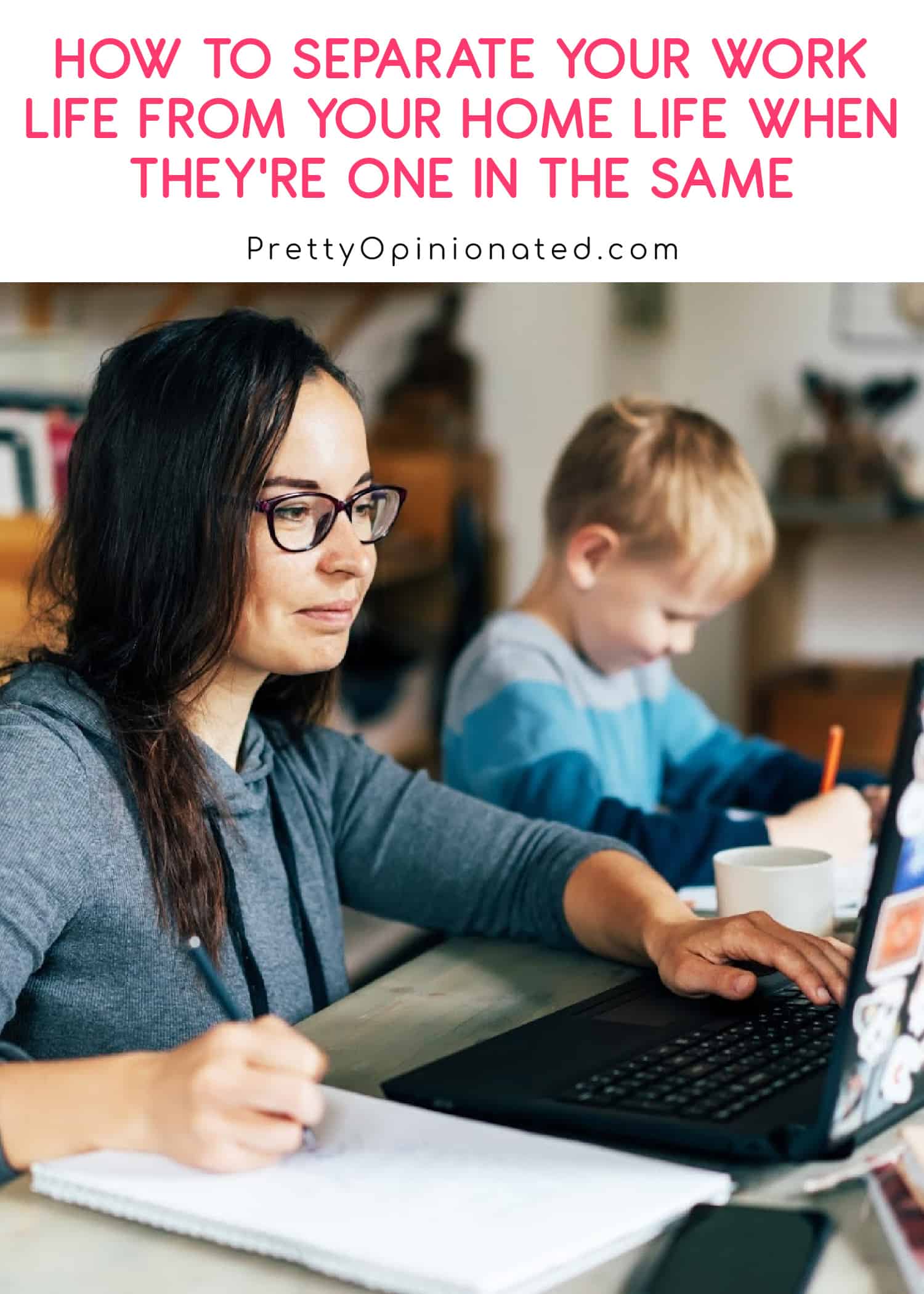It’s no secret that a well-defined office space can go a very long way towards helping you find better work-life balance. What do you do to achieve that, though, when you have a small home and no real office? Keep reading for some things that work for me.
I’ve been a work-at-home mom for the better part of the last 13 years. Early on during those years, I read a lot of “guru” posts (and let me tell you, anyone who calls themselves a guru is far from it) about how to succeed while working from home. “Have a real office totally separate from the rest of your family and free of distractions,” they said. “Get dressed for the day,” they’d advise. “Invest in organizers, label makers, fancy file system, blah blah blah blah.”
The thing that ticked me off the most about this so-called “guru” advice was the implication that you could not possibly succeed unless you did what they told you to do. Some of us really do concentrate better when wearing pajamas rather than a 3-piece business suit. Some of us have no space- or even use- for filing cabinets and fancy desk organizers.
Even more so, the vast majority of us do not live in homes large enough to create an entire space that’s totally separate from everything and everyone else. My home office is the dining room table and small shelf under my kitchen island.
Here’s one thing the so-called gurus do get right, though: if you don’t find a way to separate your work from the rest of your life, you’ll never, ever, ever, ever, ever feel like you actually “clock out.” How do you go about doing that when your office space and your “home life” space is literally both the same?
How to Separate Your Office Space from Your “Home Life” Space When They’re Both the Same
I’m no “guru,” and I’m not going to pretend that I have it all together perfectly. However, I’ve come up with some strategies over my 13+ years that really help me. Check them out. Try some, adapt others to fit your needs, and ignore those that just plain don’t make sense for your situation.
FYI, this post contains some affiliate links. If you buy through them, I get a small commission at no extra cost to you.
Choose ONE spot to do your work
If at all feasible, pick one spot in your home to do the majority of your work. For me, it’s the dining room table, because I use a desktop PC. Maybe you have a laptop and find your favorite armchair coupled with a lap desk more comfortable. Perhaps you have a cute vanity in your bedroom that can double as a desk.
The only “rule” to choosing your spot is to make sure you can actually work in it. Why is this so important? Basically, it gives you a place to “leave” at the end of the day. Which brings us to…
Physically get up and “leave work” at the end of the day
When your work day is over, close all of your essential apps (save your progress, of course). Shut down your PC/laptop/tablet/whatever. Walk away. Even if your going to use that PC for other things, just do it. I turn mine back on five minutes later to play The Sims for a bit, but the act of physically standing and declaring my day over really helps me separate my work from my life in a small home.
I also take my lunch break in another room, usually the living room. I grab my Kindle Fire HD (which I don’t use for work), load up the news or something completely not related to my job, and read while I eat. Basically, what I’d do on my lunch break if I worked outside the home.
Use separate planners for your work and your life

I have a weird obsession with planners, which is funny because I really have nothing major to plan. I’ve never been a social butterfly, and my son isn’t really into after-school activities (and he’s in cyber right now anyway to help keep my mom safe from COVID). Heck, even for my job, the vast majority of my planning and organizing is done through online services and apps.
Still, I have two physical planners. My work one is this freaking adorable one from Workman Publishing (which is half off on Amazon now that we’re into February). The other is just a small pocket planner.
Set clear boundaries with your family & friends
Tell your loved ones- and yourself- that when you’re in that space, you’re at work. So, unless it’s a dire emergency, you’re unavailable. Period. The most annoying thing in the world about working from home is the fact that others assume that you’re always available. I can’t tell you how many times I’ve heard over the years, “Oh, since you’re home, can you do XYZ for me?”
Setting boundaries is a major part of finding work/life balance for sure. You don’t need a guru to tell you that! More than just benefiting your mental health, though, it also helps you separate your work space from your life space. You’re basically telling your brain that during your “unavailable” hours, you’re in your office space. When those hours are up and you’re free to answer phone calls, you’re saying, “Now I am in my home space,” even if those two spaces are one in the same.
Turn off notifications at night and on weekends
This is something I just started doing recently, and I can’t even tell you what a huge difference it’s made! My main work clients use Facebook Messenger to let me know what she needs from me. Sometimes, they’ll message me at 9PM, or on a Saturday, or at 9PM on a Saturday.
When my notifications were on, I’d see part of the message pop up on my phone. Even if they didn’t expect a response until the next day, I felt like I HAD to at least read it to see what they needed. Unfortunately, the moment I did, they’d know, since Facebook won’t let us opt out of read receipts. So, I’d have to respond. If it was a “can you do this, this and this,” what the heck am I supposed to say? No? I guess I could, but I need the money too much to risk annoying a client.
I’d suddenly find myself doing work tasks on my days off or at 10PM when I just wanted to go relax for a bit before bed. I also found that I was working 40+ hours a week for 20 hours worth of pay. So, I started turning off my notifications every Friday afternoon at 3PM (I start work at 7AM) and leaving them off until Monday morning. If I can’t see that I have them, I don’t feel pressured to read and respond.
I REALLY wish that Facebook gave you an option to read messages without alerting the sender that it’s been read. I think it’s so freaking invasive to let every sender know the exact moment that I saw something. The day Facebook actually learns to care about their user’s privacy is the day the earth stops spinning, though. So, until that magical day comes, turn off notifications.
If you use text messages for work, enable “do not disturb” and set it up so that you only get notifications from certain people (family and friends, for example). If you have a work email, don’t check it after hours. Whatever you use, set it up so that you’re not even tempted to look outside your work hours.
Separating your work space from your actual home isn’t the easiest thing in the world when they’re one in the same. In an ideal world, we’d all have spare rooms that we could turn into offices. We rarely live in an ideal world, though. Don’t worry about what so-called gurus say. Heck, don’t even worry about what I say. The only expert on creating a work-life balance that actually works for you IS YOU. So, just do the best you can.
Last update on 2024-07-26 / Affiliate links / Images from Amazon Product Advertising API







Creating a productive and comfortable workspace at home can be a game-changer, especially in today’s increasingly remote work landscape. Creating a clear separation between your home and office space is essential for maintaining work-life balance and maximizing productivity. By implementing these tips and personalizing your workspace to suit your preferences, you can create a dedicated and inviting office space that enhances your remote work experience.